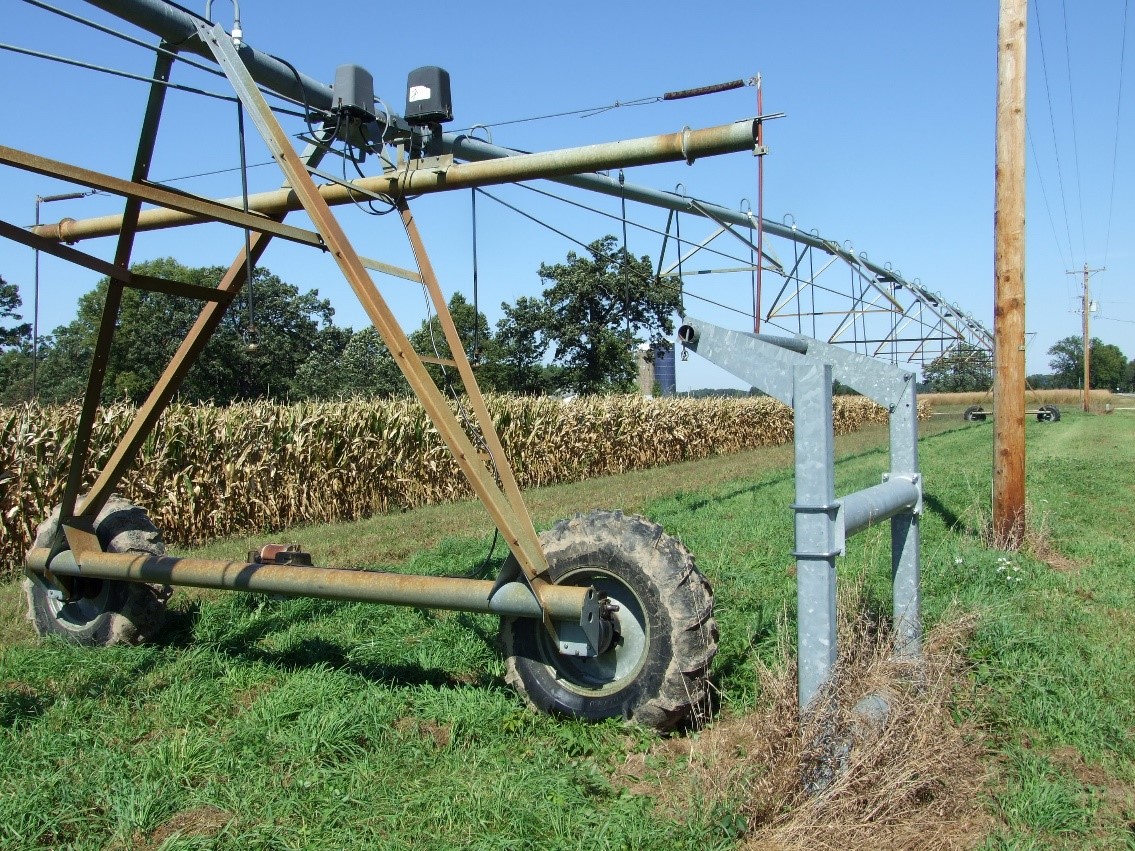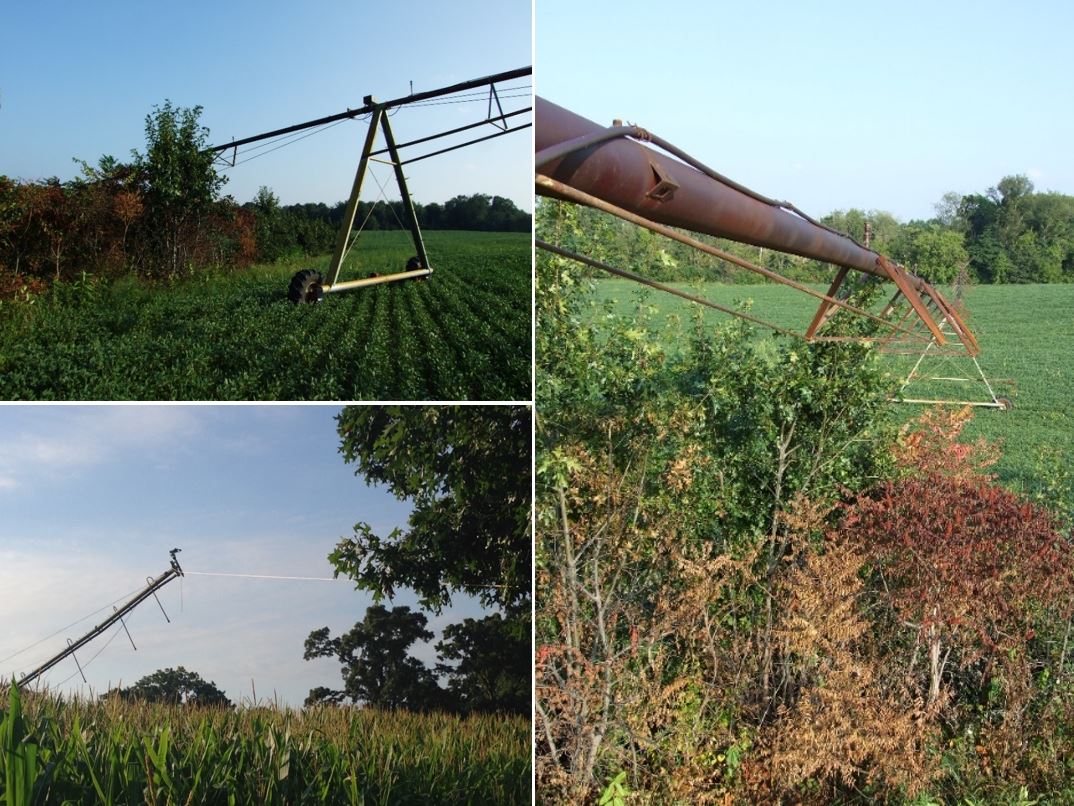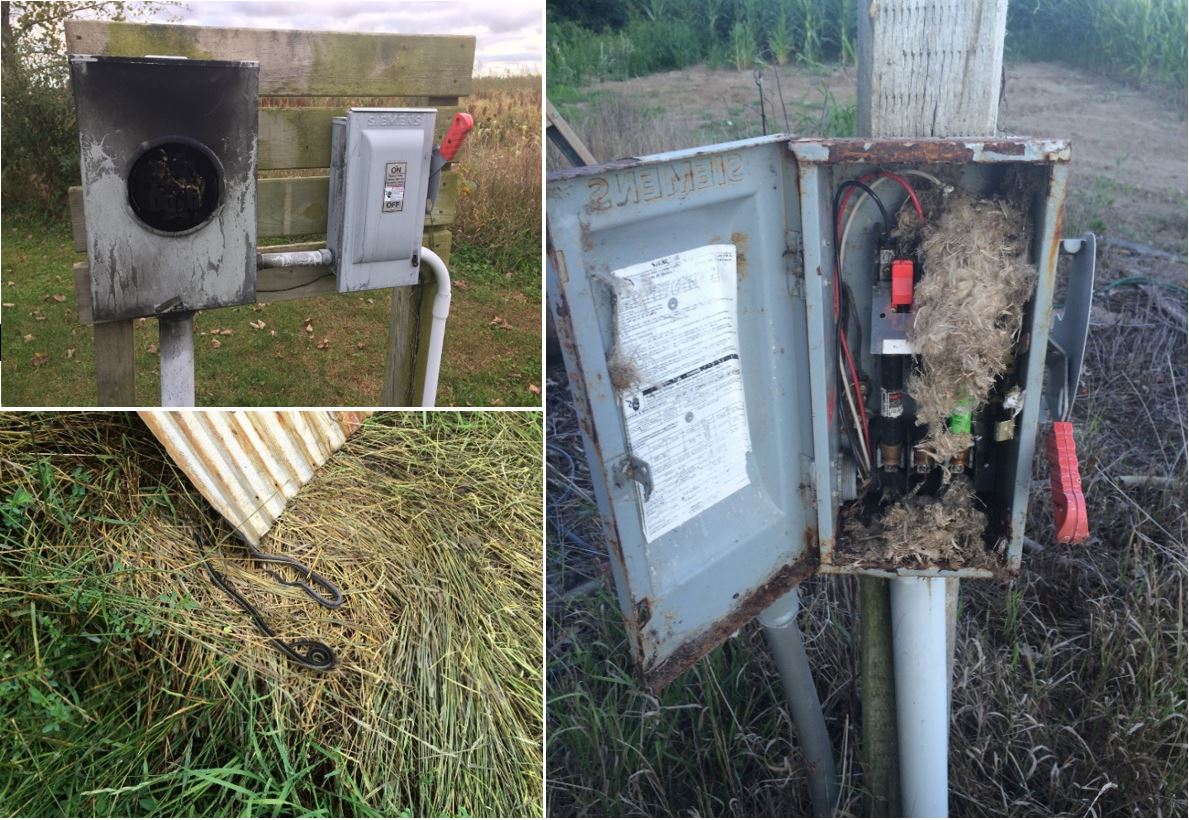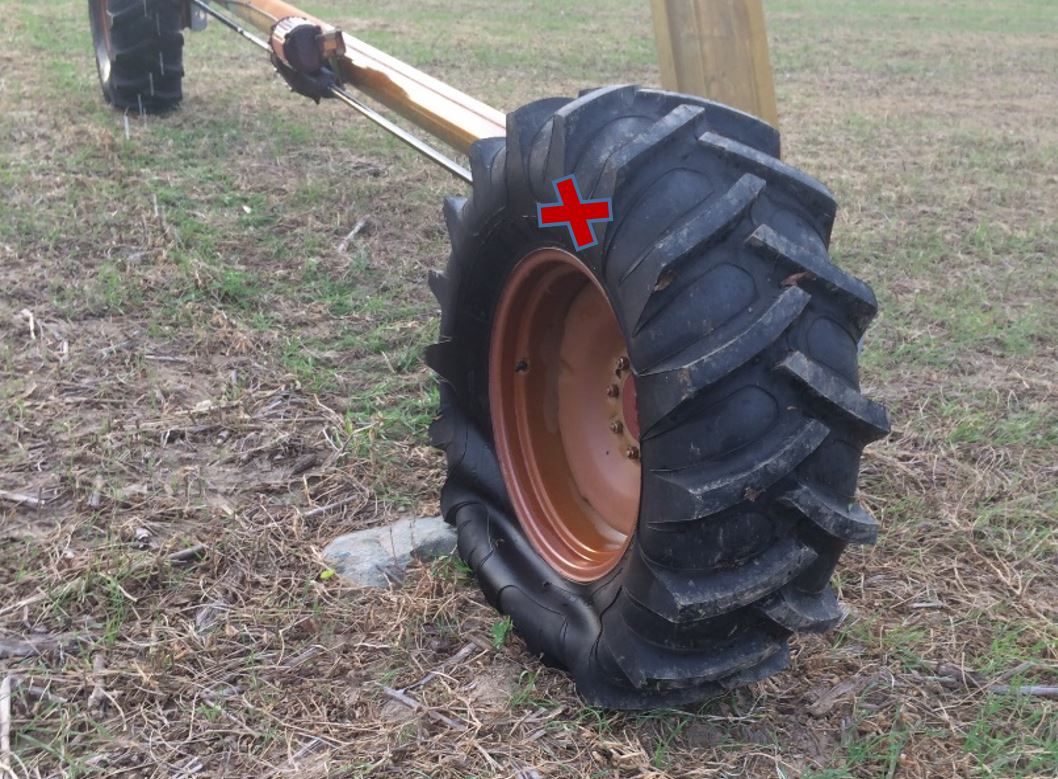Almost all crop producers are experiencing tight margins. The added expense of irrigation investment increases the need to keep expenses in check. Here are a few areas that have the potential to reduce irrigation costs while keeping yields and returns up.
Only apply water that will increase yield or profits
Suppling the water necessary to prevent water stress yield reduction is the goal of checkbook irrigation scheduling. Tracking the daily water removal, termed evapotranspiration (ET), and rainfall allow irrigators to apply the water necessary to replace the deficit. Irrigation scheduling will provide for the highest yield with the least irrigation needed.
 Test system stops and controls to make sure they function. Using barricades designed to physically catch the wheel if stop control fails can greatly reduce structural damage.
Test system stops and controls to make sure they function. Using barricades designed to physically catch the wheel if stop control fails can greatly reduce structural damage.
Indiana producers may use data from their own ET gauge station or rET (reference evapotranspiration) data from Purdue University’s PAC center weather stations. Simply multiply the reference ET by the crop coefficient (Kc), which stands for the ratio of your crops water use at its stage of development to the reference crop (6-inch grass). If you multiply that result by seven (days), you obtain the estimated corn water use per week. Support for irrigation scheduling in Indiana can be found at Purdue's Irris Scheduler.
Michigan and Indiana producers in the counties adjacent to Michigan can have daily rET data sent to them by email or text by signing up for the service at Michigan State University’s Enviroweather RPET Forecast Alert Service. Messages are sent at 5:30 a.m. each day providing rET data for the previous five days and estimates of projected rET for the following seven days from any of the network’s 87 stations. Estimates of rET can also be found by going to the Enviroweather website and following the link to “More weather” and then navigate to the “Water-use tools” heading.
 Pressurize the system and check the function of automated control that regulate flow to end guns and corner arms. Are they off when they are supposed to be? Do they come on when you need them to?
Pressurize the system and check the function of automated control that regulate flow to end guns and corner arms. Are they off when they are supposed to be? Do they come on when you need them to?
Use big irrigation applications
To make the best use of irrigation water, provide four or five days’ worth of crop water use per application, typically 1 to 1.25 inches at peak water use periods. These larger irrigation applications increase the amount of effective water available to the crop by reducing the water lost by evaporation in the crop canopy and on the residue and soil surface, about 0.1 inch per application regardless of the amount of irrigation water applied. A producer making two 0.5-inch applications provides 0.8-inch of effective water, compared to a producer making a single 1.0-inch application that provides 0.9-inch of effective water.
Irrigators with center pivots that apply water faster than can infiltrate into the soil are forced to use smaller applications (less than 0.5-inch) to avoid irrigation runoff.
Irrigate to the end
 Inspect and trim or remove trees near irrigation equipment. Limbs as small as 1 inch can topple a center pivot span if they catch in the V of the support structure. Pulling like a chain from the ground, they can roll the structure.
Inspect and trim or remove trees near irrigation equipment. Limbs as small as 1 inch can topple a center pivot span if they catch in the V of the support structure. Pulling like a chain from the ground, they can roll the structure.
Irrigate until the crop reaches maturity but no longer to increase and ensure yield and test weight. The goal of the soybean irrigator should be to maintain at least 50% of his available soil water holding capacity for soybeans till most pods yellow. Corn producers trying to maintain test weight in a dry late summer should maintain at least 50% of the available soil water holding capacity until the crop reaches black layer.
Use fertigation or spit nitrogen application to maximize return on nitrogen
Irrigated production has the advantage of fertigation as an option in nitrogen management. Fertigation is the process of applying fertilizer through irrigation water. Liquid 28% nitrogen is the most common product for fertigation with proper equipment.
From a management standpoint, fertigation allows producers the opportunity to evaluate crop stands, nitrogen losses due to wet conditions or heavy rains and the current market situation to adjust the nitrogen plan to meet the crops needs and maximize profitability. The closer the nitrogen fertilizer is applied to the time of peak crop needs, results in the least potential for nitrogen loss and the greatest return for your nitrogen investment.
Even if you never fertigate, irrigation still provides the opportunity to water in surface applied or knife in nitrogen applications. Incorporation by irrigation reduce nitrogen loss to valorization, increasing the amount of nitrogen the crop can benefit from.
Use the least expensive energy source available
 Pressurize the system and inspect for leaks, holes and damaged sprinklers. Use a crayon mark, flag or photo to identify the needed repair. The quicker the repair is made, the lower the crop damage incurred at the site. Time and winter weather can be hard on irrigation pipe and seals.
Pressurize the system and inspect for leaks, holes and damaged sprinklers. Use a crayon mark, flag or photo to identify the needed repair. The quicker the repair is made, the lower the crop damage incurred at the site. Time and winter weather can be hard on irrigation pipe and seals.
Choosing the most cost effective energy source available has the potential to have immediate and long-term cost saving. If available at reasonable installation cost, three-phase electric is the low cost source when you consider the cost of energy, equipment and maintenance. If installation cost of electricity is prohibitive, consider propane/natural gas compared to diesel fuel powered systems.
If you are lucky enough to have electric power, contact your supplier to explore potential saving from “off peak use” pricing opportunities and winter disconnect option to further lower costs.
Control systems that prevent overwatering
Automation of irrigation system can be an extra expense at a time that budgets are tight, but interlocking pumps and center pivots or other distribution systems can be done for under $500 and can avoid overwatering when the pivot stops or application cycle ends.
Maintain irrigation equipment to minimize expensive repairs
 Mice, snakes and other small vermin squeeze into electric boxes for shelter. Inspect and clean boxes before energizing for safety and to prevent equipment damage.
Mice, snakes and other small vermin squeeze into electric boxes for shelter. Inspect and clean boxes before energizing for safety and to prevent equipment damage.
Irrigation repair people seem to agree, most of the costly irrigation repairs could be avoided with preventive maintenance and precautionary start-up procedures. Here are a few of their words of wisdom:
- Remove mice, insects, vermin and their nests and waste. Close access to electrical control boxes before spring start-up.
- Clean and inspect the function of electric disconnect boxes and well starter systems.
- Test center pivot end stop controls and stop structures before the first run.
- Test traveler end run stop control system before the first run.
- Trim or remove trees and brush that are anywhere near the pivot end boom’s travel path.
- Inspect tires early in spring, add air to specification, recheck a couple weeks later, repairing any tire that lost pressure.
- Observe each center pivot drive motor and drive gearbox while running, drain accumulate water, check oil levels and refill. Growling and grinding sounds indicate the need for replacement or repair.
 Tires are ruined quickly if run while low or flat. Inspect and air tires early in the season while it is easy to get to them. Mark tire where flat and return a week later to determine if they need repaired.
Tires are ruined quickly if run while low or flat. Inspect and air tires early in the season while it is easy to get to them. Mark tire where flat and return a week later to determine if they need repaired.
Dealing with these issues before planting reduces the need for expensive repairs and minimizes the start-up time needed the first time the irrigation system is used. The added benefit of being ready to irrigate to aid in germination, emergence, incorporate fertilizer or activate herbicide often leads to a better start to a profitable year.
This article was originally published in the April 2019 Michigan-Indiana Irrigation Newsletter.